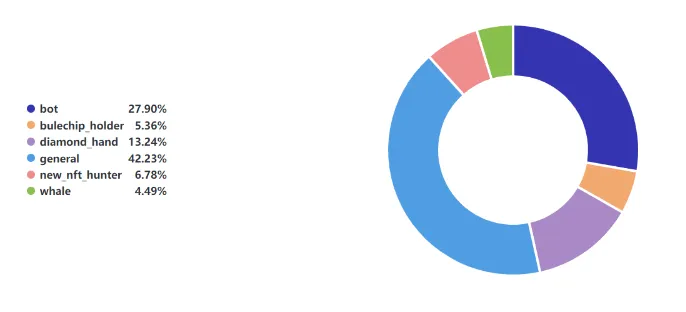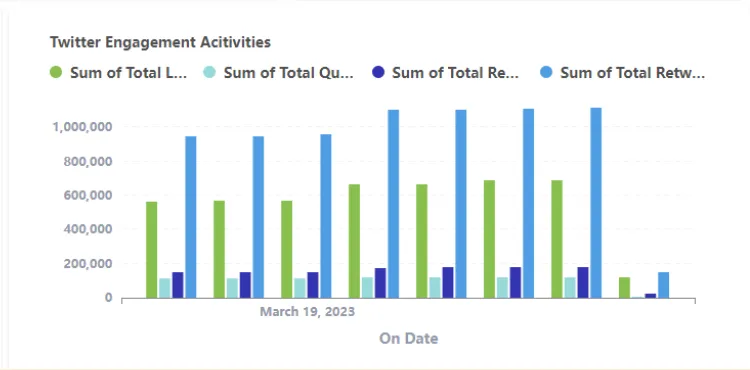

Author: lesley@footprint.network
Launching a Web3 gaming project can be an exciting and challenging endeavor. Whether you’re creating the next NFT-based collectible game or a blockchain-based multiplayer experience, building a span and engaged user group is one of the most critical factors for success.
In this article, we’ll explore some expert insights on topics such as the relationship between authentic and fake engagement, how to deal with the bot problem, and how to establish a solid user base during the pre-launch stage. No matter you’re a seasoned developer or a newcomer to the industry, these tips will assist you in achieving your future plans.
Speakers Today:
JACL 🎮 @JACL_e9 JACL is a research associate at Delphi Digital, a research arm that focuses on the digital asset industry.
Alex Wettermann @awettermann Alex Wettermann is the Head of Gaming at Shima Capital, a venture capital firm that invests in early-stage blockchain-based companies.
Sam Steffanina @SamSteffanina Sam Steffanina is a social media expert who built a YouTube channel with 13 million subscribers and has now pivoted into the Web3 space, finding his passion and work with organizations like @WolvesDAO.
Building an Authentic Community for Web3 Projects: Key Metrics to Track Before Launch
According to Sam, in today’s web3 world, big follower counts, likes and views are easy to buy, but focusing on authentic engagement is what differentiates successful brands and projects.
Authentic Engagement vs Faking Metrics
Authentic engagement refers to genuine interest and interaction from real users, while faking metrics involves manipulating or buying numbers to create the illusion of engagement. The choice between authentic community growth and fudging the numbers is critical to both the short and long term development of a project, as it forms the foundation of its success.

You may want big numbers to show at your next VC meeting, but you need real users and backers to achieve your ultimate vision. Don’t sacrifice the latter for the former. Stay true to the organic growth of real interest and support. With a span base of engaged users and community, the project will thrive long after the quick wins and big vanity metrics have faded.
Focus on metrics that show you have built real support and interest, and track signs of an activated community, such as thoughtful comments, active discussions, and individual content creation. These qualitative signals demonstrate the strength and depth of your true user base.
Buying Followers: How Much is Too Much?
While not ideal, some reliance on paid growth may be unavoidable for web3 projects. Managing hype and sustaining growth is a challenge especially in web3.
Projects can boom and then bust, even when executed well. The key is to build an authentic core audience. There is no formula for the right mix of organic and paid growth. It depends on the project and its goals. Some services offer thousands of paid followers and guaranteed engagement for months. While some paid growth may be necessary, over-reliance risks damaging reputation and liquidity.
For example, Axie Infinity posted a video that received 6 million views with only 20,000 followers. It appears to have used bots to get initial algorithmic exposure, then generated significant organic interest and discussion. If enough real interest converts to customers, the approach can work. But without a real base, growth won’t be sustainable.
Success requires a balance of paid and organic growth to build a real community willing to support the project for the long term. Bots and paid followers alone won’t create opportunity or a working economic model. Hype needs to translate into real customer interest and action.
Three key metrics suggested by Sam to measure authentic engagement:
- Real comments: Measure the quality of comments on your posts or videos. Real comments show that the person has actually read or watched your content and shared a thoughtful, customized response, rather than just using emoticons or copy-pasting comments. The more genuine comments you receive, the spaner your core audience.
- Discord activity: If you have a Discord community, measure the activity and conversation going on there. An active Discord community where members are discussing aspects of your project, sharing ideas, and helping each other shows a high level of interest and engagement. Look for consistent activity and discussion, not just people joining the channel. These community discussions are a span signal that people care about your project.
- Contest participation: When you run a contest and members of your community take the time to create their own content — like an article, video, piece of art, photo, essay, or whatever is relevant to your project — it shows an extremely high level of engagement. These people are inspired enough to spend their valuable time creating something that supports your goals. This builds a core of dedicated supporters who are invested in your project and will continue to support it over time.
Be patient and stay focused on nurturing authentic engagement. Do not rely on vanity metrics and bots, or you risk building a hollow community. Your true supporters and users are what will drive your project in the years to come.
Bot Problem in Web3 and How to Solve It
*“They make me sad. I think they harm the space quite significantly. They reduce the overall quality of content. They make it harder to stand out from these people that have really shady business practices.” *Sam said.
While the bot problem is well known, many people do not understand its severity and the massive impact it has.
Bots in Twitter Operation
In fact, it is extremely easy and cheap to gain a large number of hollow followers and false engagement metrics.
So Sam would love to raise public awareness about how incredibly easy it is, and make sure they know that not only is it easy, it’s cheap. You don’t need a big budget to do it.
Some tools can audit and remove bot followers, but it costs a fee, such as Follower Audit, which can remove bots you follow or that follow you for $15.
Also, tools like Tweetmaps can analyze audience demographics to determine if they are more likely to buy NFTs or use a product. Of course, it’s a bit of a generalization, but in general, an audience in the U.S. is more likely to be interested in web3 games than an audience in Kazakhstan, for example.
The seriousness of the bot problem should not be underestimated. It will take time and patience, but it will ultimately build real competitive advantage and lasting influence.
Bots in Game Operation
The use of bots remains an issue in web3 games that is difficult to resolve. Sam notes that there is little recourse to call out projects that use bots on a large scale. The practice is widespread because everyone wants to profit and sustain their project. The only real solution is to remove all bots, but incentive structures make that difficult.

Footprint Tagging System to Classify Users
Retaining high value users early on is key to success. Alex argues that web3 games should consider player types such as speculators, investors, and spectators as early in the design as possible. Tailor core loops and community engagement to each group based on feedback. Launching with an active, engaged player base requires identifying target users, building for them, and refining based on response.
Building a community takes time. Beginning live operations 6–12 months before launch allows games to build support for long-term player retention. Defining player types and their roles with nuance is critical to gaining an edge in the competition for attention. To retain valuable users, consider them early, build customized experiences, gather feedback to refine, and take time to nurture the community. This thoughtful, tailored approach is key to the success and sustainability of web3 gaming. It also requires collaboration across the industry.
While new tools and models empower creators, timeless principles still apply. Great games begin with knowing your players. Strong communities form around experiences created for them. Quick hype and flash in the pan success won’t last without substance to back it up.
If web3 gaming focuses on these fundamentals, this space will thrive. But if it relies only on hype, it will continue to struggle for mainstream interest and adoption. The projects and communities that survive will have the player, not the technology, at their core. By understanding the audience, designing for them, and continually optimizing to meet their needs, web3 games can achieve longevity and scale. The key is craft, not novelty — and putting in the work to build real, lasting value. With a player-centric vision and execution, the future of web3 games looks bright. But it must maintain that focus to succeed.
Find Metrics and Milestones in Pre-Game Launch Planning
Build real communities and values, not illusions. With self-awareness and flexibility, you can overcome challenges and achieve your vision. But you must pivot when necessary to optimize your chances of success. Progress comes from persisting in what really matters, not just what looks good.
Setting Meaningful Goals: Focus on What You Can Control
**When setting goals, it’s important to choose metrics that reflect the quality of your performance. **For example, instead of aiming for 500 listeners per episode over 10 shows, a better goal would be to participate in 50 high-quality Twitter spaces to build awareness before launch. Set standards to avoid “trash” Spaces.
Focus on goals you can influence and achieve, such as creating 50 unique pieces of content per month. Review performance weekly and tweak based on what works. Pivot to focus on your most effective content and activities.
Set realistic goals and revisit them regularly. Aim for meaningful progress and impact over perception. An engaged community is more important than hollow follower numbers. Adjust based on performance to optimize results.
For example, Porsche planned a collection of 10,000 items, but had no data to show they could sell that volume. By adjusting to 1,000 items, a more realistic 10% of the original plan, they sold out and prospered.
The key is to focus on what you can control. Be willing to adapt based on results and feedback. Small, tangible wins build momentum for long-term success. Appearances mean little without action and impact.
How to Achieve the Goal
When it comes to setting tangible goals and quality metrics for Web3 projects before they launch, Sam draws heavily from his Web2 experience, but adapts it to make sense for Web3. The same basic concepts apply to getting people’s attention, providing them with value, and selling them on the product.
For example, participating in Twitter Spaces attracts attention, sharing interesting insights provides value, and discussing tangible benefits of your project within the space can sell it to people, especially in longer spaces. This formula has proven effective for rampant NFT launches even in a bear market. The variables are good execution, meeting deadlines, and creating high quality, branded content tailored to your audience.
Project management, execution, content creation and consistency are important in any industry. But the content and messaging must feel native to the space. When done well, people instantly associate it with your brand. The concepts that drive marketing and sales are here to stay, but thriving means embodying them in a way that is authentic and meaningful to your audience.
Success lies not in reinventing strategies, but in applying proven ideas in innovative ways within your channel. The concepts remain, the expression evolves. Proven formulas continue to work when tailored to new communities and media. Principles stand the test of time, but manifestation is all about context. With insight and creative vision, broadly applicable theories find fresh yet familiar expression.
Key Points to Track
In early rounds, metrics like number of followers matter little compared to vision, team, and community dynamics. Active users and retention may weigh more in later rounds, but early on, authentic engagement and feedback loops best inform the opportunity. Web3 success depends on harnessing the creative energy of the community through meaningful feedback and sharing.
Projects should build community through open dialogue in the channels that users prefer. Close relationships and developer responsiveness to input cultivate a game that resonates with players and stands out from saturated market alternatives.
While later metrics may highlight scale or traction, initial increases are more about vision, ability to execute, and connection to an engaged community. Strong developer-player relationships, built on an understanding of player needs, define projects ready to deliver the experiences their base craves.
Metrics evolve with progress, but community comes first. Channels of conversation and exchange with an engaged base enable creativity that shapes the experiences your players love-and love to share. Feedback fuels innovation. Opportunities blossom with insight, understanding, and a vision that serves those you know best.
Reach and Connect with Users: Strategies and Channels to Consider
Twitter Usage to Build in Web3
Attracting a mass audience and gaining mainstream acceptance are significant challenges for any new gaming project, especially in the web3 space. Twitter seems like an obvious platform to reach web3 gamers, but its usefulness is currently nuanced, as noted by industry commentators like Alex and Sam.

Twitter Engagement Activities from Footprint Analytics
Alex argues that there are more nuanced ways to think about using Twitter. It is important to understand the reasons for using Twitter, whether it is to communicate directly with users or because of the high activity of web3 users on the platform. The profile of Twitter users may reveal many high-value, ideal customers for games. However, Twitter users alone won’t sustain a game’s economy, and using the platform to acquire users requires a deliberate approach. Developers need to know what types of users they are getting from Twitter and use those users to build the game’s economy and a broader user base.
Sam agrees that to achieve mass appeal on Twitter, web3 games need to sub-segment audiences and avoid algorithmic silos. Developers also need to understand content marketing and player engagement, which requires in-game experience. They should also meet audiences where they are with content that resonates and a multi-channel, nuanced marketing approach.
In a highly competitive gaming industry, user experience must come first. For web3 games aiming for mass appeal, the product and community should lead, with NFT and blockchain elements complementing the experience rather than defining it. Building a loyal fan base will depend on engaging, well-designed gameplay and content that keeps players coming back for more.
While new tools empower creators, relying on a single social media platform or marketing gimmick won’t lead to sustainability and scale. A great game and community, not hype, should drive real, long-term success. With experience, know-how, and the right strategy and messaging, web3 games can break through to a wider audience. Ultimately, the timeless principles of great game design and player experience will prevail.
Community Usage to Build in Web3
As JACL notes, introducing financial incentives into a community risks “corrupting the magic circle” of experience and culture. Play-to-earn models can shift player motivation away from enjoyment and toward optimizing for revenue. While balance is possible, it requires nuanced management. Historically, fan communities have often been exploited through stolen work or free labor in exchange for little. There are ways to compensate contributors fairly, but developers must strike a balance between incentives and compensation.
For web3 games, this balance is crucial, but challenging. Relying solely on financial motivations rather than gameplay and social experience will not build the loyal, lasting communities that define fanbases. Players join communities for connection, creativity, and enjoyment, not just for revenue. While money is important to sustainability, it cannot be the primary driver.
With a span vision and principles, web3 games can build fan communities that last by leading with an engaging, enjoyable product and experience. They must create incentive structures and economic models that support rather than diminish community spirit. And they must continually rebalance these systems in response to player feedback and needs.
Closing Thoughts
The road ahead for web3 gaming is filled with obstacles and uncertainty, but also immense opportunity. New tools have opened new creative horizons, but timeless principles still govern what motivates human passion and loyalty.
For developers willing to choose vision and purpose over hype, there is a chance to build something meaningful — a game, a community, an experience that taps into the human desire for authenticity, creativity, and connection.
By working and balancing humanity with innovation, web3 developers have the opportunity to cultivate cultures of meaning, imagination, and shared purpose. But not without centering values, vision, and the fundamentals of great game design. The challenges ahead are outweighed only by the potential for web3 games to inspire, provoke joy, and bring people together-if creators make that their driving goal.
By committing to community over speculation, authenticity over hype, and the principles that govern creative magic, web3 games can thrive.
Listen to the full record for the space: https://twitter.com/i/spaces/1dRKZMgkEEgxB?s=20
